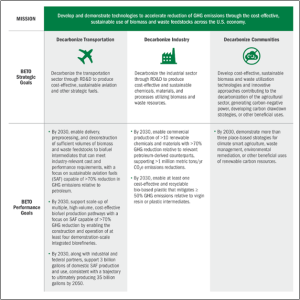ROADMAP
The U.S. Department of Energy’s (DOE) Office of Energy Efficiency & Renewable Energy (EERE) published a fact sheet on biofuel innovation in April 2022. The following are current initiatives in place to meet the goal of a 100% clean energy economy and net-zero emissions by 2050.[1]
- Biofuels for existing vehicle fleets – DOE is funding R&D to develop processes to take landfill gas or biogas from an anaerobic digester and turn it into cost effective, carbon neutral/ negative renewable diesel.
- Sustainable Aviation Fuels – BETO is researching methods to foster biofuel use for aviation by lowering costs and increasing accessibility such as developing catalysts and biocatalysts and upgrading biomass-derived intermediates.
- Lower Marine Emissions through Biofuels – BETO commissioned an effort to outline the opportunities and challenges associated with using biofuels on marine vessels.
- Biofuels to support existing fuel infrastructure – BETO is working with industry to encourage co-location of bioenergy processing facilities and the reuse of equipment and utilities to lower upfront costs and reduce long-term operating costs. BETO is also funding projects to develop data to help close gaps and risks associated with refinery integration.[2]
The Bioenergy Technologies Office Multi-Year Program Plan, updated in March 2023 by the U.S. Department of Energy’s (DOE) Office of Energy Efficiency & Renewable Energy (EERE), sets the Bioenergy Technologies Office (BETO)’s mission, goals, and strategic approach. This multi-year program plan also seeks to provide a roadmap for new innovations and allow for the de-risking of technologies across the supply chain in sustainable and clean energy. Below are BETO’s mission and goals.[3]

Source: Department of Energy, Office of Energy Efficiency and Renewable Energy, 2023[4]

Comments are closed.